Of the 20 people who each purchased 2 tickets to a concert, some used both tickets, some used only 1 ticket, and some used neither ticket. What percent of the tickets that were purchased by the 20 people were used by those people?
(1) Of the 20 people, 10 used only 1 ticket.
(2) Of the 20 people, 4 used neither ticket.
OA is C
It seems to be overlapping sets question. How to create set-matrix table for this question ?
Regards
Sachin
Of the 20 people who each purchased 2 tickets to a concert,
This topic has expert replies
- sachin_yadav
- Master | Next Rank: 500 Posts
- Posts: 212
- Joined: Mon Dec 06, 2010 12:52 am
- Location: India
- Thanked: 5 times
- Followed by:1 members
GMAT/MBA Expert
- Brent@GMATPrepNow
- GMAT Instructor
- Posts: 16207
- Joined: Mon Dec 08, 2008 6:26 pm
- Location: Vancouver, BC
- Thanked: 5254 times
- Followed by:1268 members
- GMAT Score:770
Here's how I'd solve it....sachin_yadav wrote:Of the 20 people who each purchased 2 tickets to a concert, some used both tickets, some used only 1 ticket, and some used neither ticket. What percent of the tickets that were purchased by the 20 people were used by those people?
(1) Of the 20 people, 10 used only 1 ticket.
(2) Of the 20 people, 4 used neither ticket.
Target question: What percent of the tickets that were purchased by the 20 people were used by those people?
Given: 20 PAIRS of tickets were bought by 20 PEOPLE. Some people used both tickets, some used only 1 ticket, and some used 0 tickets
So, we have the following table to represent what happened with each of the 20 PEOPLE
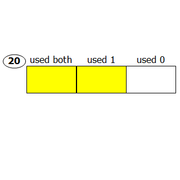
To answer the target question, we need to know the number of people in each of the two HIGHLIGHTED boxes.
Statement 1: Of the 20 people, 10 used only 1 ticket.
So, we know that there are 10 people in the middle box, but we don't know about the other two boxes. This leaves several possible cases. Here are two:
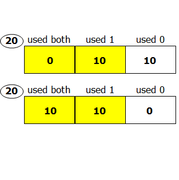
In the top case, we see that 10 of the 40 tickets were used by the purchaser. So, 25% of the tickets were used by the purchaser.
In the bottom case, we see that 30 of the 40 tickets were used by the purchaser. So, 75% of the tickets were used by the purchaser.
Since we cannot answer the target question with certainty, statement 1 is NOT SUFFICIENT
Statement 2: Of the 20 people, 4 used neither ticket.
So, we know that there are 4 people in the right-hand box, but we don't know about the other two boxes. This leaves several possible cases. Here are two:
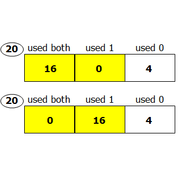
In the top case, we see that 32 of the 40 tickets were used by the purchaser. So, 80% of the tickets were used by the purchaser.
In the bottom case, we see that 16 of the 40 tickets were used by the purchaser. So, 40% of the tickets were used by the purchaser.
Since we cannot answer the target question with certainty, statement 2 is NOT SUFFICIENT
Statements 1 and 2 combined
When COMBINED the statements give us one and only one possible case:
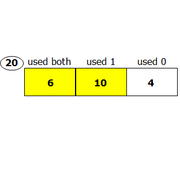
In this case, we see that 22 of the 40 tickets were used by the purchaser. So, 55% of the tickets were used by the purchaser.
Since we can answer the target question with certainty, the combined statements are SUFFICIENT
Answer = C
Cheers,
Brent
GMAT/MBA Expert
- Brent@GMATPrepNow
- GMAT Instructor
- Posts: 16207
- Joined: Mon Dec 08, 2008 6:26 pm
- Location: Vancouver, BC
- Thanked: 5254 times
- Followed by:1268 members
- GMAT Score:770
We COULD solve the question using the Double Matrix method, but it's a little confusing.sachin_yadav wrote:Of the 20 people who each purchased 2 tickets to a concert, some used both tickets, some used only 1 ticket, and some used neither ticket. What percent of the tickets that were purchased by the 20 people were used by those people?
(1) Of the 20 people, 10 used only 1 ticket.
(2) Of the 20 people, 4 used neither ticket.
OA is C
It seems to be overlapping sets question. How to create set-matrix table for this question ?
Regards
Sachin
We can examine the status of each individual ticket (1st ticket and 2nd ticket)
We'll examine all 20 PAIRS of tickets.
For the 2 rows, we can have 1st ticket used and 1st ticket not used
For the 2 columns, we can have 2nd ticket used and 2nd ticket not used
I'll let you try it this way.
HINT: One of the boxes must automatically contain a zero.
Cheers,
Brent
- GMATGuruNY
- GMAT Instructor
- Posts: 15539
- Joined: Tue May 25, 2010 12:04 pm
- Location: New York, NY
- Thanked: 13060 times
- Followed by:1906 members
- GMAT Score:790
This is an EITHER/OR group problem.sachin_yadav wrote:Of the 20 people who each purchased 2 tickets to a concert, some used both tickets, some used only 1 ticket, and some used neither ticket. What percent of the tickets that were purchased by the 20 people were used by those people?
(1) Of the 20 people, 10 used only 1 ticket.
(2) Of the 20 people, 4 used neither ticket.
Each of the 20 people EITHER used ticket 1 OR did not.
Each of the 20 people EITHER used ticket 2 OR did not.
For an EITHER/OR group problem, use a GROUP GRID (also known as a double-matrix) to organize the data.
Let 1 = used ticket 1, N1 = did not use ticket 1, 2 = used ticket 2, N2 = did not use ticket 2.
Here is the grid:
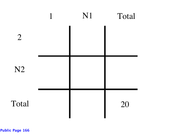
In a group grid, the entries in any given row or column must add up to the TOTAL of that row or column.
Statement 1: Of the 20 people, 10 used only 1 ticket.
Let x = the number of people who used only ticket 2, implying that the number of people who used only ticket 1 = 10-x.
The following grid is yielded:
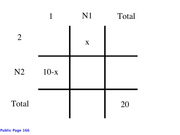
No way to determine how many tickets were used.
INSUFFICIENT.
Statement 2: Of the 20 people, 4 used neither ticket..
The following grid is yielded:
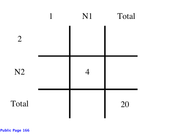
No way to determine how many tickets were used.
INSUFFICIENT.
Statements combined:
The following grid is yielded:
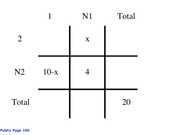
Since the entries in any given row or column must sum to the total of that row or column, we get the following grid:
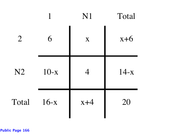
Total tickets used = (total ticket 1) + (total ticket 2) = (16-x) + (x+6) = 22.
Since each of the 20 people purchased 2 tickets -- for a total of 40 tickets -- and 22 of the 40 tickets were used, we get:
Percentage used = (22/40) * 100 = 55%.
SUFFICIENT.
The correct answer is C.
Private tutor exclusively for the GMAT and GRE, with over 20 years of experience.
Followed here and elsewhere by over 1900 test-takers.
I have worked with students based in the US, Australia, Taiwan, China, Tajikistan, Kuwait, Saudi Arabia -- a long list of countries.
My students have been admitted to HBS, CBS, Tuck, Yale, Stern, Fuqua -- a long list of top programs.
As a tutor, I don't simply teach you how I would approach problems.
I unlock the best way for YOU to solve problems.
For more information, please email me (Mitch Hunt) at [email protected].
Student Review #1
Student Review #2
Student Review #3
Followed here and elsewhere by over 1900 test-takers.
I have worked with students based in the US, Australia, Taiwan, China, Tajikistan, Kuwait, Saudi Arabia -- a long list of countries.
My students have been admitted to HBS, CBS, Tuck, Yale, Stern, Fuqua -- a long list of top programs.
As a tutor, I don't simply teach you how I would approach problems.
I unlock the best way for YOU to solve problems.
For more information, please email me (Mitch Hunt) at [email protected].
Student Review #1
Student Review #2
Student Review #3
GMAT/MBA Expert
- Brent@GMATPrepNow
- GMAT Instructor
- Posts: 16207
- Joined: Mon Dec 08, 2008 6:26 pm
- Location: Vancouver, BC
- Thanked: 5254 times
- Followed by:1268 members
- GMAT Score:770
I thought I'd point out that Mitch's "group grid" approach is also known as the Double Matrix Method. This technique can be used for most questions featuring a population in which each member has two characteristics associated with it.
Here, we have a population of people, and the two characteristics are:
- used ticket 1 OR did not use ticket 1
- used ticket 2 OR did not use ticket 2
This question type is VERY COMMON on the GMAT, so be sure to master the technique.
To learn more about the Double Matrix Method, watch our free video: https://www.gmatprepnow.com/module/gmat- ... ems?id=919
Once you're familiar with this technique, you can attempt these additional practice questions:
Easy Problem Solving questions
- https://www.beatthegmat.com/the-aam-aadm ... 72242.html
- https://www.beatthegmat.com/finance-majo ... 67425.html
Medium Problem Solving questions
- https://www.beatthegmat.com/probability- ... 73360.html
- https://www.beatthegmat.com/posted-speed ... 72374.html
- https://www.beatthegmat.com/motel-t271938.html
- https://www.beatthegmat.com/of-the-appli ... 70255.html
- https://www.beatthegmat.com/opening-nigh ... 64869.html
- https://www.beatthegmat.com/ds-french-ja ... 22297.html
- https://www.beatthegmat.com/prblem-solving-t279424.html
Difficult Problem Solving questions
- https://www.beatthegmat.com/ratio-problem-t268339.html
- https://www.beatthegmat.com/overlapping- ... 65223.html
- https://www.beatthegmat.com/fractions-t264254.html
- https://www.beatthegmat.com/overlapping- ... 64092.html
- https://www.beatthegmat.com/mba/2011/05/ ... question-2
Easy Data Sufficiency questions
- https://www.beatthegmat.com/for-what-per ... 70596.html
- https://www.beatthegmat.com/ds-quest-t187706.html
Medium Data Sufficiency questions
- https://www.beatthegmat.com/sets-matrix-ds-t271914.html
- https://www.beatthegmat.com/each-of-peop ... 71375.html
- https://www.beatthegmat.com/a-manufacturer-t270331.html
- https://www.beatthegmat.com/in-costume-f ... 69355.html
- https://www.beatthegmat.com/mba/2011/05/ ... question-1
Difficult Data Sufficiency questions
- https://www.beatthegmat.com/double-set-m ... 71423.html
- https://www.beatthegmat.com/sets-t269449.html
- https://www.beatthegmat.com/mba/2011/05/ ... question-3
Cheers,
Brent
Here, we have a population of people, and the two characteristics are:
- used ticket 1 OR did not use ticket 1
- used ticket 2 OR did not use ticket 2
This question type is VERY COMMON on the GMAT, so be sure to master the technique.
To learn more about the Double Matrix Method, watch our free video: https://www.gmatprepnow.com/module/gmat- ... ems?id=919
Once you're familiar with this technique, you can attempt these additional practice questions:
Easy Problem Solving questions
- https://www.beatthegmat.com/the-aam-aadm ... 72242.html
- https://www.beatthegmat.com/finance-majo ... 67425.html
Medium Problem Solving questions
- https://www.beatthegmat.com/probability- ... 73360.html
- https://www.beatthegmat.com/posted-speed ... 72374.html
- https://www.beatthegmat.com/motel-t271938.html
- https://www.beatthegmat.com/of-the-appli ... 70255.html
- https://www.beatthegmat.com/opening-nigh ... 64869.html
- https://www.beatthegmat.com/ds-french-ja ... 22297.html
- https://www.beatthegmat.com/prblem-solving-t279424.html
Difficult Problem Solving questions
- https://www.beatthegmat.com/ratio-problem-t268339.html
- https://www.beatthegmat.com/overlapping- ... 65223.html
- https://www.beatthegmat.com/fractions-t264254.html
- https://www.beatthegmat.com/overlapping- ... 64092.html
- https://www.beatthegmat.com/mba/2011/05/ ... question-2
Easy Data Sufficiency questions
- https://www.beatthegmat.com/for-what-per ... 70596.html
- https://www.beatthegmat.com/ds-quest-t187706.html
Medium Data Sufficiency questions
- https://www.beatthegmat.com/sets-matrix-ds-t271914.html
- https://www.beatthegmat.com/each-of-peop ... 71375.html
- https://www.beatthegmat.com/a-manufacturer-t270331.html
- https://www.beatthegmat.com/in-costume-f ... 69355.html
- https://www.beatthegmat.com/mba/2011/05/ ... question-1
Difficult Data Sufficiency questions
- https://www.beatthegmat.com/double-set-m ... 71423.html
- https://www.beatthegmat.com/sets-t269449.html
- https://www.beatthegmat.com/mba/2011/05/ ... question-3
Cheers,
Brent
- sachin_yadav
- Master | Next Rank: 500 Posts
- Posts: 212
- Joined: Mon Dec 06, 2010 12:52 am
- Location: India
- Thanked: 5 times
- Followed by:1 members
Mitch and Brent,
Thank you so much for your explanations. They are extremely good. The practice questions on this type will definitely help.
Regards
Sachin
Thank you so much for your explanations. They are extremely good. The practice questions on this type will definitely help.
Regards
Sachin
Never surrender
-
subhakimi
- Newbie | Next Rank: 10 Posts
- Posts: 4
- Joined: Mon Jan 19, 2015 9:24 am
- Thanked: 2 times
- GMAT Score:760
Your approach is redundant. It's basically an equation question.sachin_yadav wrote:Of the 20 people who each purchased 2 tickets to a concert, some used both tickets, some used only 1 ticket, and some used neither ticket. What percent of the tickets that were purchased by the 20 people were used by those people?
(1) Of the 20 people, 10 used only 1 ticket.
(2) Of the 20 people, 4 used neither ticket.
OA is C
It seems to be overlapping sets question. How to create set-matrix table for this question ?
Regards
Sachin
We have three variables of which one is known and since each statement gives the value of one variable any of then can answer the question.
Each statement alone is sufficient
Answer is C.
CAT/GMAT trainer in India.
Consistent 99%iler in CAT
Consistent 99%iler in CAT
-
Matt@VeritasPrep
- GMAT Instructor
- Posts: 2630
- Joined: Wed Sep 12, 2012 3:32 pm
- Location: East Bay all the way
- Thanked: 625 times
- Followed by:119 members
- GMAT Score:780
Not quite: neither statement alone is sufficient, but the two statements TOGETHER are sufficient. You're essentially treating the question assubhakimi wrote:We have three variables of which one is known and since each statement gives the value of one variable any of then can answer the question.
Each statement alone is sufficient
x + y + z = 20. What is (2x + y)/40?
S1:: y = 10
S2:: z = 4
for which we need both statements to solve.
GMAT/MBA Expert
- Scott@TargetTestPrep
- GMAT Instructor
- Posts: 7263
- Joined: Sat Apr 25, 2015 10:56 am
- Location: Los Angeles, CA
- Thanked: 43 times
- Followed by:29 members
We can create the following formula:sachin_yadav wrote:Of the 20 people who each purchased 2 tickets to a concert, some used both tickets, some used only 1 ticket, and some used neither ticket. What percent of the tickets that were purchased by the 20 people were used by those people?
(1) Of the 20 people, 10 used only 1 ticket.
(2) Of the 20 people, 4 used neither ticket.
Total people = # who only used only 1 ticket + # who used both tickets + # who used neither ticket
20 = # who only used only 1 ticket + # who used both tickets + # who used neither ticket
Since each of the 20 people bought 2 tickets, a total of 40 tickets were bought. Of course, not all tickets were used since some used only 1 ticket and some used neither ticket. We need to determine what percentage of the tickets that were purchased by the 20 people were used by those people.
Statement One Alone:
Of the 20 people, 10 used only 1 ticket.
We see that the # who only used only 1 ticket is 10. However, since we know nothing about the number of people who used neither ticket, we still cannot answer the question. Statement one alone is not sufficient.
Statement Two Alone:
Of the 20 people, 4 used neither ticket.
We see that the # who used neither ticket is 4. However, since we don't know the number of people who used only 1 ticket, we still cannot answer the question. Statement two alone is not sufficient.
Statements One and Two Together:
Using the information from statements one and two, we see that:
20 = 10 + # who used both tickets +4
Thus, 20 - 14 = 6 people used both tickets.
Since a total of 40 tickets were purchased and only (6 x 2) + (10 x 1) = 22 were used, the percentage of tickets purchased by the 20 people that were used is 22/40 x 100 = 11/20 x 100 = 55 percent.
Answer: C
Scott Woodbury-Stewart
Founder and CEO
[email protected]

See why Target Test Prep is rated 5 out of 5 stars on BEAT the GMAT. Read our reviews






















